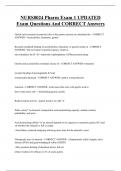NURS8024 Pharm Exam 1 UPDATED
Exam Questions And CORRECT Answers
Gastric acid secretion by parietal cells of the gastric mucosa are stimulated by - CORRECT
ANSWER- *acetycholine, histamine, gastrin
Receptor-mediated binding of acetylcholine, histamine, or gastrin results in - CORRECT
ANSWER- *the activation of protein kinases, which in
turn stimulates the H+/K+-adenosine triphosphatase (ATPase) proton pump
Gastrin and acetylcholine stimulate release of - CORRECT ANSWER- histamine
receptor binding of prostaglandin E2 and
somatostatin diminish - CORRECT ANSWER- gastric acid production
Antacids - CORRECT ANSWER- weak bases that react with gastric acid to
form water and a salt → diminishing gastric acidity
Reduce pepsin activity - pepsin inactive at a pH >4
Wide variety* in chemical composition, acid-neutralizing capacity, sodium content,
palatability, and price
Acid neutralizing ability* of an antacid depends on its capacity to neutralize gastric HCl and
on whether the stomach is full or empty
• food delays stomach emptying, allowing more time for the antacid to react
Therapeutic uses of antacids - CORRECT ANSWER- • Symptomatic relief of peptic ulcer
disease (PUD) and gastroesophageal reflux (GERD)
• May promote healing of duodenal ulcers, but not
robust evidence for efficacy in Tx of acute gastric
,ulcers
• Calcium carbonate preparations
• also used as calcium supplements for the treatment of osteoporosis
Commonly used antacid drugs - CORRECT ANSWER- Classes
• Calcium salts: calcium carbonate: Tums/Rolaids
• Sodium bicarbonate: Alka-Seltzer
• Aluminum salts - Aluminum hydroxide: Amphojel; Aluminum carbonate: Basaljel
• Magnesium salts/ magnesium oxide: Milk of Magnesia
• Combination products
• Aluminum hydroxide and magnesium hydroxide (Maalox, Mylanta)
• Alginic acid, magnesium trisilicate, calcium stearate
(Gaviscon)
Adverse effects of antacids - CORRECT ANSWER- • Aluminum hydroxide tends to be
constipating
• Magnesium hydroxide tends to cause diarrhea
• Binding of phosphate by aluminum-containing antacids → hypophosphatemia
• Sodium bicarbonate → belching and flatulence, potential for systemic alkalosis
• Sodium content of antacids → can be important in pts w/ HTN or CHF
• Excessive intake of calcium carbonate along w/ calcium foods → hypercalcemia
Mucosal Protective Agents - CORRECT ANSWER- Cytoprotective compounds
Sucralfate
Bismuth Compounds
Cytoprotective Compounds - CORRECT ANSWER- enhance mucosal protection
mechanisms → preventing mucosal injury, ↓ inflammation, promotes healing of existing
ulcers
Sucralfate - CORRECT ANSWER- complex of aluminum hydroxide and sulfated sucrose
,• Small, poorly soluble molecule
• Polymerizes in stomach acid → binds to injured tissue, forms physical barrier coating over
ulcer bed- impairs diffusion of HCl and prevents degradation of mucus by pepsin and acid
• Accelerates healing of peptic ulcers and ↓ recurrence rate
• Stimulates prostaglandin release, mucus and bicarbonate output
• *BIG drawback.... Must be taken qid• used in long-term maintenance therapy to prevent
recurrence
• Requires an acidic pH for activation -should not be administered with H2 antagonists or
antacids
• Little of the drug is absorbed systemically, very well tolerated
• Can interfere w/ absorption of other drugs by binding to them
• Does not prevent NSAID-induced ulcers
Bismuth Compounds - CORRECT ANSWER- • Coats ulcers → protective layer against acid
and pepsin
• May stimulate prostaglandin, mucus, and bicarbonate secretion
• Antimicrobial effect- binds enterotoxins
• reduces stool frequency & liquidity in acute infectious diarrhea
• Causes black stools- harmless
• Avoid in renal insufficiency
In geriatric patients avoid use of - CORRECT ANSWER- - antacids that contain magnesium
in patients with renal failure
- sodium-containing antacids because of fluid
retention
Antacids in Pediatrics - CORRECT ANSWER- Safety not established in children
Antacids during pregnancy and lactation - CORRECT ANSWER- No FDA category
established, although antacids
generally are considered safe for use in pregnancy
, Antisecretory agents - CORRECT ANSWER- Histamine-2 receptor antagonists
Proton pump inhibitors
Examples of Histamine-2 receptor antagonists - CORRECT ANSWER- ranitidine,
*cimetidine, famotidine, nizatidine
Examples of Proton pump inhibitors - CORRECT ANSWER- • omeprazole, esomeprazole
• Lansoprazole, pantoprazole
• rabeprazole
H2 Receptor antagonists - CORRECT ANSWER- • MOA
• Acts selectively on H2 receptors in the stomach, blood vessels, and other sites (no effect on
H1 receptors)
• Competitively blocks binding of histamine to H2 receptors
• less effective than PPIs against stimulated secretion
• Four drugs: cimetidine*. ranitidine, famotidine, and nizatidine
• Can inhibit > 90% basal, food-stimulated and nocturnal secretion of gastric acid after a
single dose
• Main clinical use is to inhibit gastric acid secretion
• particularly effective against nocturnal acid secretion
H2 Receptor antagonist ADEs - CORRECT ANSWER- • H2 antagonists very safe
• ADE < 3% of patients - diarrhea, h/a, fatigue, myalgias, constipation
• Drugs such as ketoconazole, which depend on an acidic medium for gastric absorption, may
not be efficiently absorbed if taken w/ H2 blocker
• Not used for NSAID-induced ulcers
• Better healing and prevention with PPIs
Cimetidine - CORRECT ANSWER- • Inhibits cytochrome P450 and can slow metabolism -
potentiating the action of other drugs
• warfarin, diazepam, phenytoin, quinidine,
carbamazepine, theophylline, and imipramine




